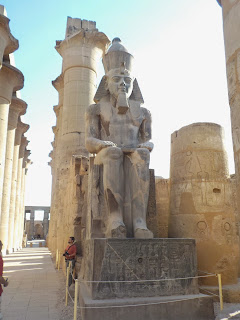After leaving Edfu, we passed through a lock that lowered
the boat 6 meters and we continued downstream to Luxor (formerly Thebes) arriving in
the afternoon. From Luxor, we traveled by van across the Nile to the west side
and into the hills to the Valley of the Kings, home of the underground tombs of
the pharaohs dating from the 16th to 11th century BC. There are 63 known tombs
including Tutankhamun’s. We were able to visit three tombs. In the first tomb we
descended 7 or 8 stories at a steep grade. The others were relatively flat. Unfortunately,
cameras were banned from the Valley of the Kings a few years ago to prevent
deterioration of the colors painted on the carved stone walls. Typically, the tomb
interiors (walls and ceilings) were covered in carved and painted hieroglyphs. The tombs
we visited were in remarkable shape given they were thousands of years old, but
having been buried in such a dry climate must have helped.
Temple of Hatshetsup
Heiroglyph at the Temple of Hatshetsup
Temple of Hatshetsup
Valley of the Queens
Karnak Temple Complex
Karnak Temple Complex
Karnak Temple Complex
Karnak Temple Complex
Karnak Temple Complex
Karnak Temple Complex - big scareb
Karnak Temple Complex
Karnak Temple Complex
Karnak Temple Complex
Karnak Temple Complex
Karnak Temple Complex
Karnak Temple Complex
Luxor Temple - paintings uncovered by cleaning in recent months
Luxor Temple
Luxor Temple
Luxor Temple - Avenue of the Sphinx
Luxor Temple
Luxor Temple
Luxor Temple
We also visited the Temple of Hatshetsup, one of the most
powerful and long-reigning queens to have ruled Egypt. The temple was badly
damaged by her step son when he usurped her.
Polish archeologists reconstructed the temple, maybe going a bit too
far.
We went south to the Valley of the Queens where wives of
Pharaohs and other nobles were buried in underground tombs. There are more than
70 tombs. The two we visited were similar to the king’s tombs.
Luxor Temple In the afternoon, we visited the Karnak Temple
Complex, located in Luxor. Construction of the complex began 4,000 years ago
and continued up until the time the Romans took control of Egypt, about 2,000
years ago. The complex is a vast open-air museum covering 250 acres. It is the
second largest ancient religious site in the world, after the Angkor Wat.
The last place we visited right in Luxor was the Luxor
Temple built 1500 to 1200 BC. Ramesses II had much of the later work completed
and many of the statues and hieroglyphs depict him.Temple of Hatshetsup
Heiroglyph at the Temple of Hatshetsup
Temple of Hatshetsup
Valley of the Queens
Karnak Temple Complex
Karnak Temple Complex
Karnak Temple Complex
Karnak Temple Complex
Karnak Temple Complex
Karnak Temple Complex
Karnak Temple Complex
Karnak Temple Complex
Karnak Temple Complex
Karnak Temple Complex
Karnak Temple Complex
Luxor Temple - paintings uncovered by cleaning in recent months
Luxor Temple
Luxor Temple
Luxor Temple - Avenue of the Sphinx
Luxor Temple
Luxor Temple
Luxor Temple























I think I have the same picture of the bee and wheat.
ReplyDelete